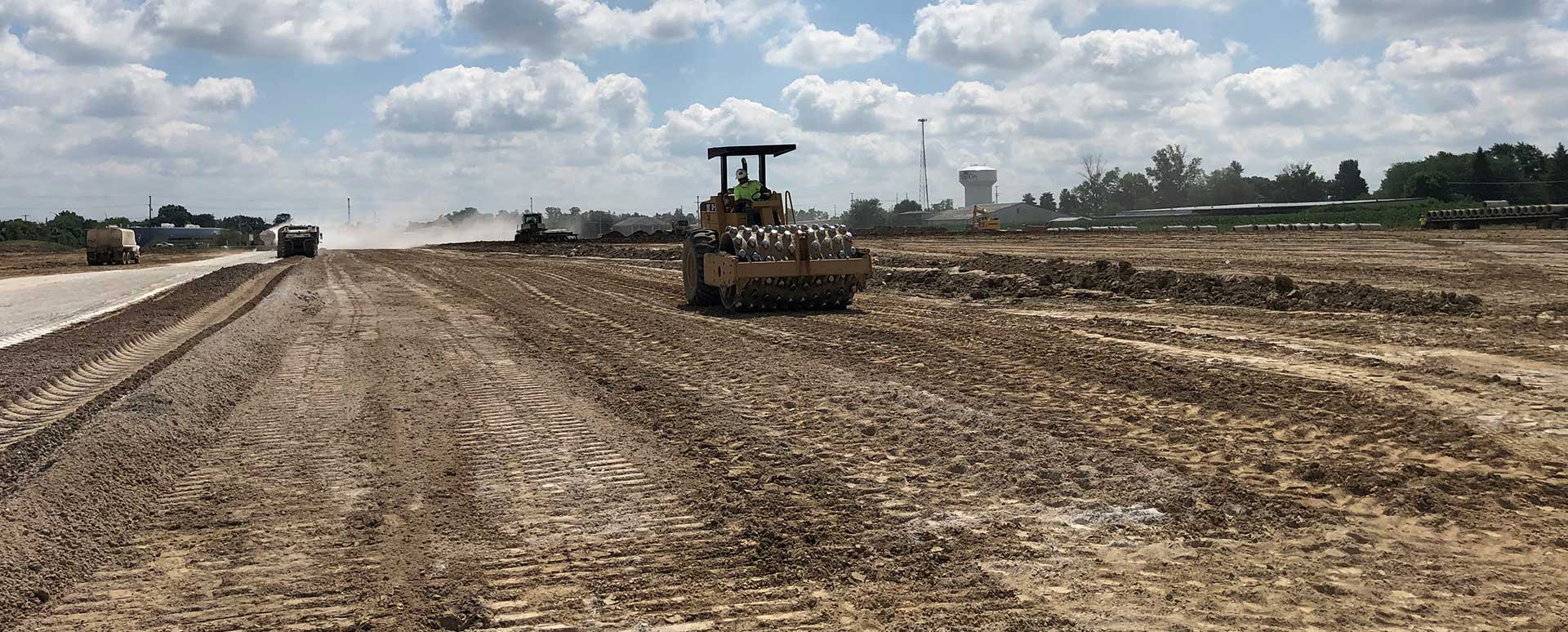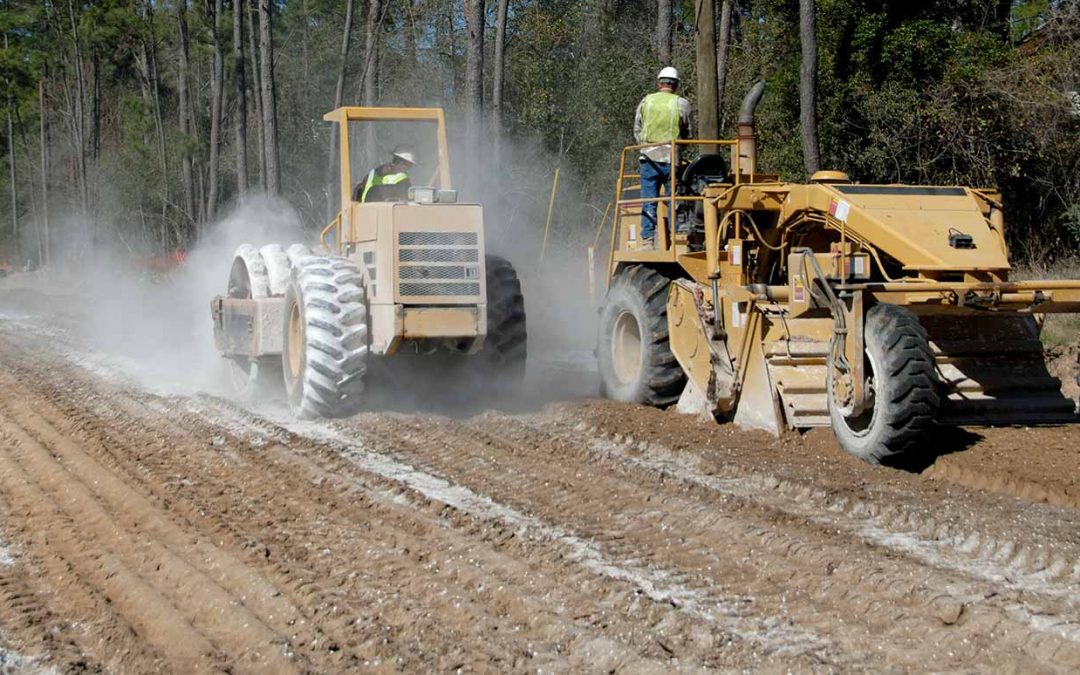Mix the soil with chosen percentage of lime and cure for 72 hours. An additional 05 to 1 lime could be added to allow for variation in mixing and pavement materials.

Q A 155 What Is Lime In Civil Work Engineering Notes Civil Engineering Civil Engineering Design
The entire process can be completed in 3 to 7 d.

. The principle involved in lime-soil stabilization is the exchange of ions between lime and soil when addedWhen clayey soil is treated with lime Cation exchange takes place between them which increases plastic limit and reduces plasticity index which finally results in increase in stability of soil. Construction sites in Texas often encounter the challenge of wet. However hydrated high calcium lime Ca OH2 monohydrated dolomitic lime Ca OH2MgO calcitic quicklime CaO and dolomitic quicklime.
The design procedure which includes selection of the optimum percentage of lime rapid cure. Lime slurry shall contain a minimum of 30 dry solids content. This paper presents the results from a labo-ratory investigation of stress-strain-strength development of four lime-stabilized soils under 28 day.
The cracking problem for lime-stabilized base courses. This manual focuses on the subsequent construction aspects of treating soils with lime. Inspect seedbed just before seeding.
The rehealing properties of some mixtures. The optimum lime design occurs when the plot of UCS versus lime peaks. Use the mix design procedure for lime stabilization to determine the percent required to stabilize the material.
For over five decades lime has been utilized to improve and stabilize roadway soils throughout the state of Texas. The testing and design of stabilized soil layers is addressed elsewhere. Choose a lesser percentage than the percent required for stabilization.
Relation of strength to percent of lime with emphasis on effect of curing time. Developing a proper mix design and testing is the first step. In-place mixing is used to add the appropriate amount of lime to the soil mixing it to an appropriate depth.
From residential streets to the most demanding highways and airfields lime has proven to be the best solution for solving the problems of the high plasticity clay soils and inadequate base materials. Determined by the mix design. Mix the soil wit h chosen percentage of lime and cu re for 72 hours.
A design process for lime-stabilized airfield pavement layers are described. Modification and Stabilization of Soils 1-6 TxDOT 092005 Base for Use in Pavement Structures Lime is formed by the decomposition of limestone at elevated temperatures. Quicklime and hydrated lime shall conform to the physical and chemical properties of AASHTO M 216 or ASTM C977.
The mix design of the lime treated mixture type of lime to be used and its. APPLICATION OF THEORY INTO PRACTICE Review. In an effort to assist you in recommending lime stabilization in sulfate-bearing clays the following general recommendations are made.
The effect of moisture lime content purity oflime andfine ness of lime on early loss of cohesion in raw soil. Use the mix design procedure for lime stabilization to determine the percent required to stabilize the material. Sulfate Levels Too Low to be of Concern by weight of soil then lime stabilization should not be of significant concern.
Britpave Soil Stabilization. The range of UCSs should be between 1020 MPa with a target UCS of 15 MPa at 28 days to make the lime stabilisation successful. Determine the group classification of the lime.
Use ASTM C136 10 procedures to determine the amount of soil. REACTIONS PROPERTIES DESIGN AND CONSTRUCTION. The potential for a harmful reaction is low.
Lime stabilization is not a complex process and is easy to carry out. When lime is combined with water and the soluble silica and alumina present in clay a chemical reaction occurs resulting in the formation of new compounds. Using Lime Stabilization FDR103 Revised.
Steps for Mixture Design and Testing for Lime Stabilized Soil Step 1 Initial Soil Evaluation Purpose. Principle of Lime-Soil Stabilization. The final harrowing or discing operation should be on the general contour.
Evaluate key soil characteristics as an initial step to determine if it is suitable for lime stabilization. Ii establishment of optimum lime content based on the pH test and compressive strength test. Work lime and fertilizer into the soil as nearly as practical to a depth of 4 inches with a disc springtooth harrow or other suitable equipment.
Choose a lesser percentage than the percent required for stabilization. Plasticity Index 15-18. E For Lime Pretreatment.
When lime stabilization is recommended the soil support value SSV may be raised to 35 or. E For Lime Pretreatment. Known as the Lime Demand augmented by 28 day UCS testing to establish the optimum lime content.
Continue tillage until a reasonable uniform seedbed is prepared. New Stabilisation Standards and Guidance Steve Dunn Managing Director Geofirma Soils Engineering Ltd. Pulverization and mixing is used to thoroughly combine the lime and soil.
EN16907 - Earthworks Part 1 Principles and Design. For many years various forms of lime including products with varying degrees of purity have been utilized successfully as soil stablizing agents. The dosage rates of lime for construction also referred to as additive content by mass will be the greatest of the lime demand test results and the lime required to achieve the target UCS of 15 MPa at 28 days.
Major discrepancies in the lime stabilization design methods as used in different countries mainly deal with. Up to 10 cash back Little developed a protocol for lime mix design to soil which is based on i reactivity of soil minerals with lime. Volume Change 20-30 Clay Content 25-30.
However good mix design and construction. And iii evaluating resistance to moisture-induced damage through a capillary suction. When dealing with these typesoils always recommend lime stabilization to the outside edges of the shoulders.
2013 BSM Stabilisation Design1 Natural Material Charactr Grading Moisture density Mod Atterberg Limits PI ITS select active filler Step 1 150mmφ dry wet ITS select bitumen Step 2 150mmφ dry wet equil Typical Bitumen 0 1Lime 1Cem 3 reps Selected active filler-04 -02 0 02 3 reps Bit. Laboratory tests and mix designs that fit the demands of the particular project and provide the most economical alternative for the planned use.

Macadam Pavement Built On Lime Stabilization Ver 6 Download Scientific Diagram
![]()
What Is Soil Stabilization Soil Stabilization Methods Types Of Soil Stabilization

Soil Stabilization Methods And Materials Mintek Resources

Soil Stabilization Importance Benefits Mintek Resources

Soil Stabilization With Lime Cement Anese

Utilization Of The Lime As Subgrade Stabilizer In The Pavement Construction Springerlink

Figure 3 From Soil Stabilization Using Lime Semantic Scholar

Lime Vs Cement Which Soil Stabilization Method Is Better Mintek Resources
0 comments
Post a Comment